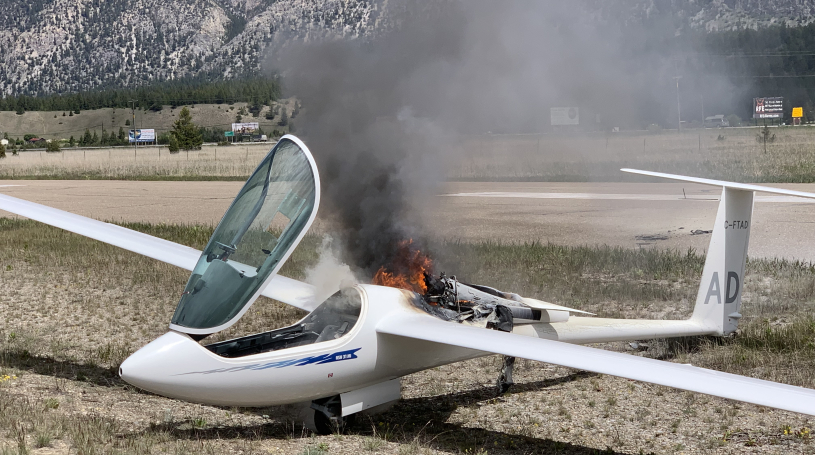FIRE IN THE AIR! A Glider Pilot’s Narrow Escape
by: Herrie ten Cate
It was the first good soaring day of the season, clear skies, a solid forecast, and high spirits. My ASH 31 Mi, a high performance self-launching 21-metre sailplane was fully fueled, thoroughly inspected, and ready for flight at Invermere Airport in British Columbia. In this type of sailplane, the engine is behind the pilot in the fuselage, and the propellor is brought up and down electronically.
I took off on Runway 15 under normal conditions: temperatures, RPMs, and performance all in range.
At 500 feet, I began my usual post-takeoff checks: retracted the gear, adjusted the flaps, throttled back, and turned off the secondary fuel pump.
That’s when things went wrong. The engine suddenly died.
I quickly turned the secondary fuel pump back on and managed to continue climbing. Then, I noticed an alarming message on the ILEC engine control unit: “0L”. My first thought was oil, but I soon realized it meant zero fuel.
Moments later, the engine stopped again, and this time I smelled smoke. With the engine located behind me, I couldn’t see flames, but I knew the glider was on fire. Training took over.
I immediately turned back toward the airfield, deployed the landing gear, engaged the prop lock to reduce drag, and radioed ahead for help. I asked fellow pilots to meet me with fire extinguishers.
I landed safely on Runway 15, intending to roll out near the hangars. But shortly after touchdown, the cockpit filled with smoke. I brought the glider to a stop and evacuated immediately.
Seconds later, a six-foot column of flame erupted from the engine area. The entire flight, from takeoff to evacuation, lasted less than seven minutes. Once the fire began, I was on the ground within two to three minutes.
We tried using handheld fire extinguishers, but they were no match for the blaze. Fellow pilot Harry Peters urged us to get the burning glider off the runway. We grabbed the cockpit rails and pulled it onto the dirt, away from landing traffic. We also salvaged the aircraft documents, oxygen tank, and canopy.
A water truck from the Shuswap Band arrived quickly and began hosing down the fire. About 10 minutes later, a fire truck arrived—but parked directly on the runway. It took repeated, heated requests to move it off the active strip, as other gliders were still airborne and depended on Invermere for landing.
I believe a fuel line rupture may have caused the fire, allowing fuel to pump directly into the engine bay where it was likely ignited by the exhaust. A visible blue fuel stain on the tail fin offers another clue. The investigation is still ongoing.
In hindsight, this was both the worst and best day of my gliding career. Worst, well for obvious reasons, but best because I lived to tell the tale. Later that evening, I celebrated my 27th wedding anniversary with my wife, grateful to be alive, and even more committed to flying safely.
Takeaways for Every Pilot
Emergencies don’t announce themselves politely, they erupt fast. Here’s what I hope every pilot takes away from my experience:
- Know your POH inside and out.
- Get in your cockpit and physically rehearse emergency procedures.
- Have a plan for the unthinkable. The pilots who plan-ahead are often the ones who walk away.
- Never assume it won’t happen to you.
- After any aircraft maintenance carry out a detailed inspection of the work done.
- Small airports are often far away from emergency services. Have a crash kit on hand with things like fire-proof gloves, fire axe, metal cutters, hack saw and anything else you can think of. Have it clearly marked and make sure everyone knows where it is. Time is often critical.
- If the airfield has a vehicle, make sure it has a fire extinguisher.
- Invite the local emergency services to the airfield on a yearly basis. Even offer to hold a mock training session
After reading the report into the Swiss Air disaster that happened off the coast of Nova Scotia in the 1990s, I knew that if I ever smelled smoke, I would land immediately. The Swiss Air crew took too long trying to figure things out.
Learn from others.
Stay sharp. Stay safe. Fly again.
About the Author:
Herrie ten Cate lives in Invermere, B.C., and has been an avid glider pilot for over four decades. He holds both a private pilot licence and a glider pilot licence and has been a dedicated COPA member for more than 25 years. Herrie is also the host of The Thermal Podcast, a show dedicated to the world of soaring.

